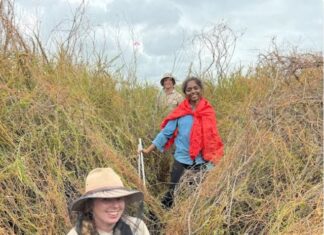Last night (9 April) SBS screened a documentary in which former television presenter Ray Martin travelled to the Outback with a photographer mate and spent time with the people who call these wide open spaces “Home”.
To a person, these folk stated that they would not live any place else.
The work may be hard; but they love their lives way out there.
Ray Martin and his mate were taken by helicopter in search of an ancient landscape feature called “The Running Man” up in Queensland’s north-west.
With delight, they were able to show this place to some of the traditional overs of this land; descendants of the Kalkadoon people whose roaming and hunting lands these used to be.
But Ray and his friends were told by these people of the dark history of this place.
For decades during the 19th Century, the Kalkadoon warriors fought a guerilla campaign against the encroaching white troopers and settlers.
After each lightning strike, the Kalkadoon warriors would melt back up into the hill country between Cloncurry and Mount Isa.
They would inflict heavy casualties upon any troopers unwise enough to follow them up there.
However, spears can hold out against repeater rifles for only so long.
The Kalkadoon people were massacred.
Those warriors who managed to survived were lead away in chains to church-run missions, where aboriginal people were beaten for trying to practice their culture and speak their languages.
The Kalkadoon people were by no means the only aboriginal people to suffer dispossession, massacre and destruction of their culture.
Ray and his friends got to speak with an older aboriginal man who related that his grandfather had survived by submerging himself beneath a tree trunk in a creek and by breathing through a reed.
What this aboriginal man and his companions stated will go a long way to bringing about healing in “truthtelling”; an acknowledgment on the part of the descendants of the white settlers who perpetuated these atrocities of the wrong that was done to the ancestors of these aboriginal people.
For then, this aboriginal man stated, we can all go forward together.
However, even in the midst of this past darkness, there were some rays of light.
When the Skyring family took up land around the creek that now bears their name, just to the south of Gympie, they found an aboriginal encampment there.
The Skyrings left these people alone.
Their young son, Zachariah used to go to play with these Kabi aboriginal children.
He learned to speak their language.
Later in life, he compiled a Kabi/English dictionary; a copy of which is kept in the local history section of the Gympie Library.
Every year, young Zachariah would go walkabout with these Kabi aboriginal people up to the Bunya Mountains for the annual bunya nut feast.
The tribes used to gather together up there not just for the feasting, but also for storytelling and corroborees.
During the late 1990s, my son and I, and later, my late wife, got to know a man whose aboriginal name is Gundurhu.
This man’s father was aboriginal, while his mother was Irish.
Gundi therefore had one foot in Roman Catholicism, and the other foot in the Dreamtime.
This man was a gifted artist.
He would use a straw to do-paint the most huge and absolutely beautiful landscapes and portraits.
Gundi gave my late wife and I a most precious gift.
Once, when he had to move house, he asked us if we could take his beloved Staffie, Gypsy.
My late wife and I were only too happy to do so.
Gypsy became very much a part of our family.
I write this letter in tribute to Gundi.
I hope you are still with us in mortal flesh, old friend.
I wish there were more people like you.
– John Hermann
Gympie






